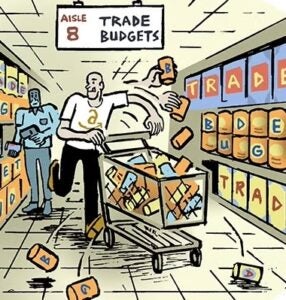 “Data Driven Thinking” is a column written by members of the media community and contains fresh ideas on the digital revolution in media.
“Data Driven Thinking” is a column written by members of the media community and contains fresh ideas on the digital revolution in media.
Today’s column is written by Rob Leathern, CEO of XA.net, a demand-side platform.
The companies like ours that started looking at the buying-side opportunity in display in 2007 were encouraged by what appeared to be a looming shift of a large portion of the addressable online inventory to centrally addressable, priced, biddable ad inventory (partially driven by Right Media and their early commitment to a robust API). Some of this vision has come to pass, but crucially, there is far less than we hoped and it is taking far longer than hoped for. Here are some reasons why the reality of this centralization continues to lag the hype and the hope:
Publisher inertia and lack of compelling options: Publishers have not yet had a clean inventory management option from any centralized ad exchange, publisher optimizer, ad server or other entity compelling enough to make them radically shift the way they are doing things to push more inventory into a centralized market or addressable channel. We’ve seen several big publishers pushing inventory through 5 or 6 ad exchange, ad network and optimizer channels often without seeming rhyme or reason as to how it is set up in these individual systems. There is a huge disconnect between possibility and reality in these systems. We’ve worked with brand-name publishers via the Right Media Exchange who’ve quickly abandoned it as too complex; or in one case we had to abandon them because the convoluted way they set up their ad tags in this exchange led to slow ad serving and 40% discrepancies.
Inadequate protection from malware: Related to the previous point, the centralizers of supply have had trouble keeping bad demand out. This is an issue that has affected EVERY SINGLE company in our space on both ends, even Google – and the more decentralized the payment part of the ecosystem is, the more room for bad stuff to creep in which is why Right Media, which doesn’t manage the payment part of the equation, has been historically more susceptible. The reality here is that there is no foolproof automatic way to do this stuff – trust and verification at the market level need to be more systematized.
Over-reaching for Real-time bidding and me-too-ism: Several companies have skipped past the step of making their inventory centrally available via ad exchanges (there are problems with this I’ll get into below) right to the promise of real-time bidding (RTB). Quite a few supply-side networks/aggregators have publicly thrown their hat into the RTB game without actually having built, or even spec’d out internally, a solution, in order not to be left behind in the perception game. Guys – if someone can automatically bid on millions of impressions but before they do that they have to manually create a campaign in your system, that kind of defeats the point doesn’t it?
Lack of standardization in API design: One of our engineers remarked that one company’s RTB spec looked like it was “cut and paste directly from their internal requirements wiki” in clear haste to have something to show people, without concern about whether the requirements made any sense or not, not to mention another’s that looked like it was “mostly copied from this other spec”. The ideal would be everyone would have a standard API and campaign/creative design taxonomy, of course, but unfortunately superficial similarities only are a cause for some concern. If we could all agree (mostly) on a set of ad sizes that work for most sites, why can’t we agree on a set of standards for automatically getting ads onto those sites?
Slow API roll-out: I’m not only talking about the new Google/Doubleclick AdX 2.0 system here but it seems to be a common refrain in our space. Still waiting for that API. Sometimes it’s hard not to feel like Vladimir or Estragon, “[holding] the terrible silence at bay”.
Publisher ad servers still suck, and publisher optimizers still small: I had the misfortune of helping implement publisher-side ad serving for a few large enterprise publishers and it’s a god-awful mess even starting from scratch let alone having a legacy operational structure with direct and remnant systems. Publisher optimizers like Pubmatic/Rubicon/Admeld/mediageeks (I’ll call them PRAM for short) have stepped in to provide services that help publishers figure out how to manage ad network relationships and by extension to some extent, their remnant inventory (sort of). This type of stuff should and is being built into the next generation of publisher adservers. Talk abounds about the next generation of simple, tag-based, mass-market ad serving solutions from Google etc. etc., but the issues of internal process management and sales incentive alignment won’t go away any time soon. Suffice it to say, though, that regardless of the promised new solutions and new players that plan to create a more liquid secondary market for inventory for advertisers while simultaneously improving the prospects for publishers, their traction has still been fairly limited to date.
As a demand-side company, I love and support our PRAM friends because they aggregate thousands of midsize, small and large publishers that we no longer have to worry about provided they can get access to a decent volume of their remnant inventory. I want to help them get bigger and stay viable, so that I can more efficiently buy inventory. But I can’t say I’m 100% sold that that will indeed happen quickly or without much pain.
Shifting allegiances and business models: It is all still early days, and some of the companies on the leading edge who are helping to educate the market are still – themselves – shifting their shape and business model. The confusion and mistrust this causes retards progress and it isn’t over yet. In the next three months, look for at least two biggish companies in the space to make some moves that will upset their partners and further muddy the waters.
I think the best and only solution is going to be honest, direct, discussion – the kind often sorely missing at industry events. And thus I don’t have answers but my quick takeaways for “online advertising optimization solutions”, buy-side optimizers, exchanges and honest-to-goodness inventory owners to help get the ball rolling:
- Prove that you can make more money selling stuff in a market. It almost seems absurd to say, but I think we need more real, cold, hard, cross-tabbed, fully disclosed, no-caveat data to share about how this centralized market stuff can make a publisher more money. I remember the compelling data that Right Media showed semi-privately at AdTech about optimizing Yahoo! Class 2 inventory a couple of years ago that made the point, but we should now be at a place we can do some robust tests and show the data to the world. Please figure out some good ways to do this, with real attributed information. Maybe we need an FDA-like human trial for this stuff (minus the 7-year turnaround) to prove it works – I dunno, just lets get some real data, quickly!
- Don’t say stupid shit to scare publishers. Agency person tells publisher rep “why should I buy your inventory from you for $2.00 when I’m getting it for $1.10 from [exchange]?” There is zero upside to this conversation – it’s like telling the guy next to you on the plane you paid half the price he did for his ticket. Just like that example, there’s usually a rational reason why you got a deal like not knowing the airline or flying at a different time than you’d like – lower session-queue impressions, non-guaranteed, small volumes. They most likely ARE NOT the same products you are trying to compare, and besides if the publisher really wants to sell it to you for less than $2.00, they will. Rather use the opportunity to see those impressions in a bidded market as an opportunity to test impressions out without spending time on getting IOs signed. If you need more volume from them, don’t cry – pay up or move on! Everyone should be treating their ad business as a revenue-maximizing operation and if they are and you don’t say stupid stuff like this, you’ll get the right inventory at a fair price.
- Do the simple things first. Step 1) for me is centralized inventory availability in a bidded market, without a real-time bidded component. The “real-time” part of RTB is aimed at reducing the need to manage a centralized cookie system and complex decisioning infrastructure on the part of the seller, but it also reduces capabilities. For example, one cannot easily run a CPA or CPC campaign since there needs to be an independent assessment of the likely eCPM of these campaigns to make their bid comparable. This is one reason why in some regards Doubleclick AdX 2.0 is inferior to Google Adwords since there are fewer ways to buy. Take a step back and why not make a straight tag-insertion/campaign creation API available first before then tying in RTB to that existing API infrastructure? Again, automatically bidding on container campaigns that had to be created by hand seems like horse cart before the.
- Think API before thinking AP (Associated Press). Press releases about the availability of yet another “real-time” whatever system don’t do any of us any good if we can’t create campaigns, ad groups, line items or creatives in your system without having to get some person on our end, or your end, or both, to talk to someone else (shudder) or to type stuff into a user interface all over again. Data providers, too, are now starting to provide varying degrees of API into their systems. Some of them still focusing just on inventory/segment discovering and size assessment vs. actual purchasing of data and transfer of cookie credentials. Another thing is when you design your APIs, standardize wherever possible, and don’t work in a vacuum – engage sophisticated integrators early on to get their feedback into what you’re building. Finally, make sure your systems can scale to lots of inputs and lots of campaigns (hence the point of an API). When you launch, having several companies already pushing automated volume into your system is a nice story to tell.
Follow Rob Leathern (@robleathern), XA.net (@xa_net) and AdExchanger.com (@adexchanger) on Twitter.













